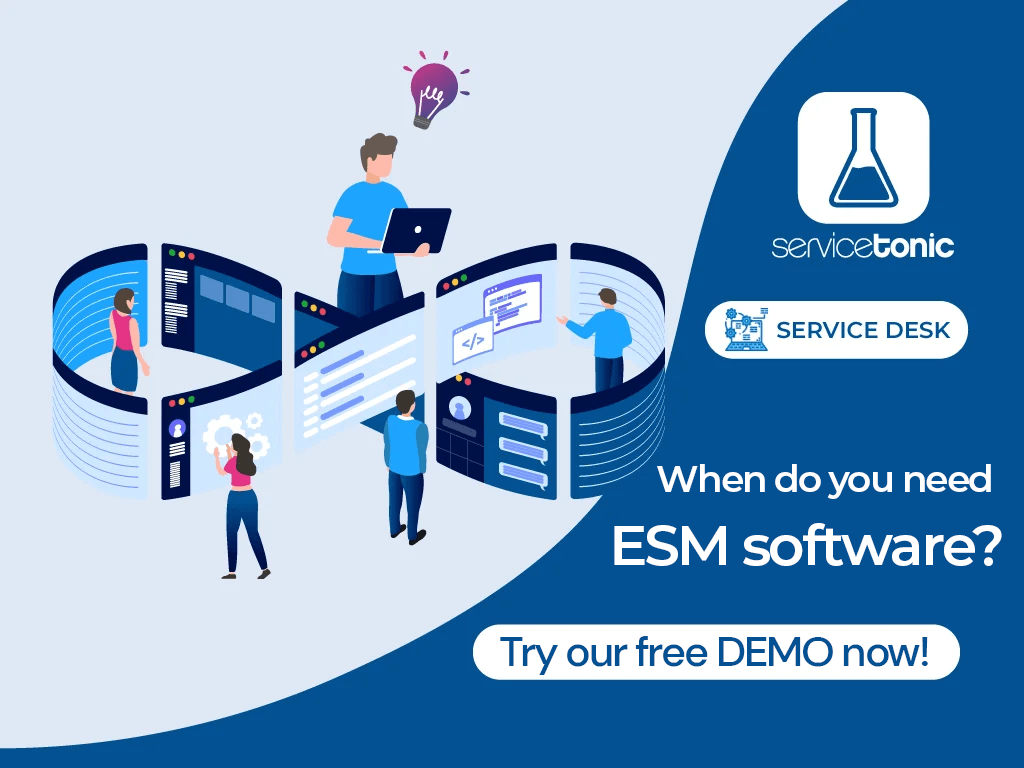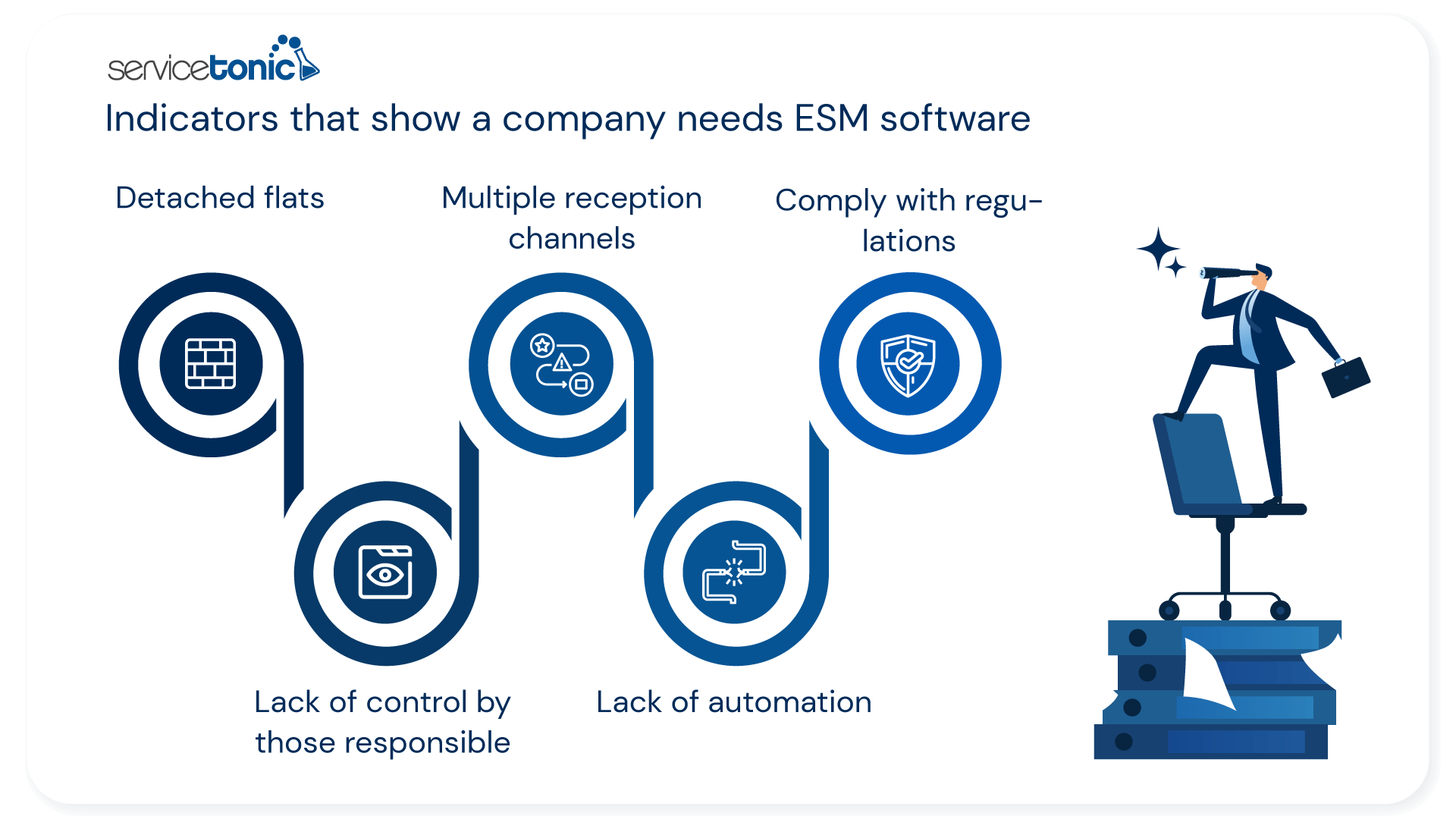
Adopting Enterprise Service Management (ESM) software becomes essential when a company needs to manage services across the business, beyond IT. These platforms unify processes, encourage cross-department collaboration, and deliver a faster, more consistent experience for employees and end users.
Enterprise Service Management has become a strategic approach in the industry to identify improvement opportunities, increase operational efficiency, and enhance both the internal and external experience across the organization.
This raises the question: does every company need ESM software? When is the right time? What signals show it’s time to take the step?
There are clear indicators to determine when to introduce an ESM solution, especially when it includes AI to optimize service management and strengthen responsiveness to business demand.
Table of Contents
What is Enterprise Service Management (ESM)?
Enterprise Service Management (ESM) is built on the principles of IT Service Management (ITSM), a discipline focused on optimizing technology services through best practices such as ITIL. This approach improves support quality, shortens response times, and increases operational efficiency in IT.
ESM extends ITSM principles to other business functions such as HR, Finance, Procurement, and Legal to unify service delivery, accelerate incident resolution, and offer a more consistent, efficient experience for internal users. With the right management software, organizations can overcome challenges related to interdepartmental coordination and process standardization.
The ultimate goal is to establish a working culture that promotes transparency, continuous improvement, and excellence in enterprise service delivery.
Implementing ESM software solution enables companies to centralise request management, automate workflows, and obtain key metrics for continuous improvement.
Why an ESM solution drives business efficiency and collaboration
Adopting an ESM solution is more than a technology upgrade; it’s a work philosophy focused on efficiency, collaboration, and high-quality service delivery across the organization. This approach applies Service Management principles to every department, breaking down silos and fostering a service-oriented culture.
Service delivery stops being exclusive to the </help-desk-software-for-it-service-providers/”>IT department and becomes a cross-functional practice that involves every team interacting with employees or end users. As a result, the organization gains a unified view of processes, smoother communication, and faster handling of requests and incidents, strengthening the service experience and boosting overall productivity.
Implementing ESM solution means embracing a modern, user-centric business philosophy that accelerates cross-department collaboration and optimizes resources to deliver faster, more consistent, value-driven services.
Benefits of adopting ESM software for the organization
Implementing Enterprise Service Management (ESM) software provides strategic advantages that improve overall service management and optimize the experience for both employees and end users.
1. Centralized, efficient service delivery
ESM software lets you manage all requests, tasks, and processes from a single platform, improving cross-department coordination and reducing response times. This centralization eliminates duplication, optimizes resources, and ensures faster, more consistent service for employees and end users.
With this unified view, the company achieves more orderly and efficient management of internal operations.
2. Service-oriented organizational culture
Adopting an ESM solution embeds a work philosophy centered on collaboration, transparency, and continuous improvement. It promotes standardized processes and automated workflows that ensure quality and consistency in every service delivered.
By extending ITSM principles across the organization, each function contributes actively to the satisfaction of both internal and external users.
3. Continuous improvement and faster incident resolution
A key benefit of ESM is the ability to resolve incidents more quickly and accurately. Through automation, metric tracking, and real-time reporting, organizations can identify improvement opportunities and anticipate potential disruptions.
The result is more stable, efficient service delivery aligned with business objectives.

Indicators that show a company needs ESM software
1.Departments operate in silos
If each department handles its internal requests with its own tools—for example, IT with a ticketing system, HR replying only by email, and Sales using custom forms, communication breaks down and request resolution slows.
ESM unifies service management on a single platform, enabling cross-department collaboration, reducing duplication, and optimizing resources.
2. Lack of visibility for department managers
In many organizations, managers can’t answer essential questions:
- How many requests did we receive this month?
- What is our average response time?
- Which incident types are most frequent?
- How many requests remain unresolved?
- Which agents have the highest workload?
Business effectiveness requires tools to measure and analyze results. ServiceTonic’s ESM software lets you build custom dashboards and generate reports without coding, providing clear KPI visibility and supporting data-driven decisions.
3. Multiple intake channels for requests
When user requests arrive through multiple channels and aren’t centralized, information gets scattered, processes suffer, tracking becomes difficult, and productivity drops. Adopting an ESM solution like ServiceTonic centralizes requests in one place, streamlines management, and improves the user experience.
Centralizing requests in a single system is key to better operational efficiency and service control. ServiceTonic makes this possible, improving management and communication with users.
4. Lack of automation
ServiceTonic ESM automates key service processes, such as auto-assigning tickets to the right owner based on criteria like request type, urgency, or department.
These automations are simple to configure without programming, helping organizations speed response times, reduce manual errors, and improve operational efficiency from day one.
Automating processes with ServiceTonic boosts efficiency and reduces team workload. Its easy setup delivers value without technical expertise.
5. Compliance requirements
An ESM platform like ServiceTonic simplifies compliance with standards such as ISO 27001 by centralizing service management and ensuring process traceability, control, and documentation.
It also enables structured incident and risk management, supporting secure operations aligned with information security standards.

FAQs when implementing ESM software
What is ESM (Enterprise Service Management)?
Enterprise Service Management (ESM) is a business strategy that applies IT Service Management (ITSM) practices across different areas of an organization.
It extends IT service management principles to departments such as HR, Finance, Sales, and more.
ESM uses software to automate and improve internal processes, leading to greater efficiency in service delivery and a better experience for employees and customers.
What are the benefits?
Organizations can gain several advantages when adopting ESM software:
- Faster response and resolution times, since centralizing requests in one solution prevents anything from being lost.
- Better employee experience through timely, effective answers.
- Fewer errors and repetitive tasks thanks to automations built by agents according to company standards.
- Higher overall productivity.
- Support processes aligned with business objectives.
When is the right time to move to ESM?
The best time to implement ESM software isn’t when chaos has already set in, but when the first signs of inefficiency appear. Situations that suggest your company is ready include:
- You already have a mature ITSM platform and want to extend its benefits to other departments.
- You’re digitizing internal processes and need a cross-functional platform.
- You’ve grown quickly and internal processes no longer scale.
- You’re launching new business lines or opening offices.
- You have multiple disconnected tools and need to unify them.
How do you choose the right ESM software?
There are several ESM platforms on the market, which makes selection more complex, as not all offer the same capabilities or cover business needs equally.
- Is it flexible and adaptable to your processes?
- How complex is it to use and maintain?
- Can you customize workflows without relying on the technical team?
- Does it integrate with other corporate tools?
- Does it provide custom reports or dashboards to visualize KPIs?
- Is there a support team from day one?
- How configurable is it?
- Does it include built-in AI to improve operational efficiency?
ServiceTonic is a modular, scalable, user-centric ESM solution, ideal for organizations looking to optimize internal services without complicating their tech stack.
One of our key advantages over other solutions is built-in AI that accelerates processes, anticipates needs, and improves decision-making.
Conclusion
When an organization identifies any of the indicators above, it’s likely time to move to Enterprise Service Management (ESM).
Implementing an ESM solution is not just a technology upgrade; it’s a strategic move focused on efficiency, transparency, and the satisfaction of employees and end users.
To see how ServiceTonic can be tailored to your organization’s needs, request a personalized demo with our expert team.
